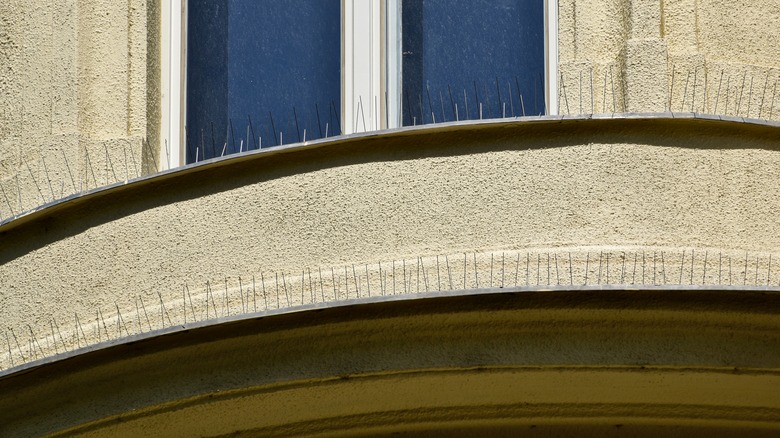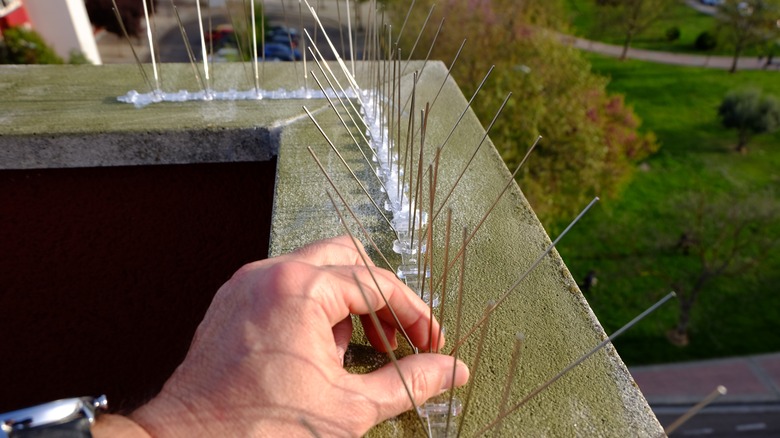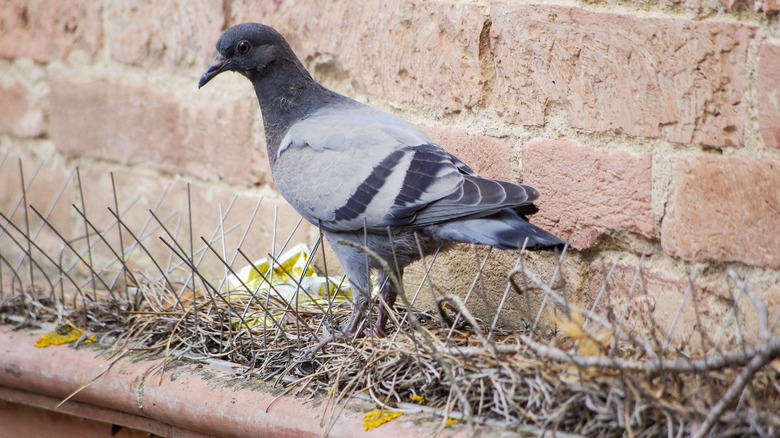What It Means If You Spot A Home With Spikes Installed On The Roof
If you've ever walked by a home or building and spotted spikes on the roof or in the gutters, that's because the property owners are doing what they can to ward off birds. Don't let the sharp spikes make you jump to conclusions, though — this is one of the kindest ways to discourage nesters.
If you've ever dealt with birds nesting on your roof, you'll know all about the problems they pose. From damage to drains to droppings, which aren't just unsightly but can also seriously tarnish the material of your roof, winged houseguests can be a recipe for disaster. So much so, in fact, that some experts even suggest calling in exterminators if you spot them nesting. Understandably, however, most bird lovers don't love that idea. Enter, the solution promoted by both The Humane Society of the United States and PETA: spikes.
Mounted spikes that point in multiple directions make it tough for birds to get into roofs, gutters, or anywhere else they may try to build nests. Of course, some birds may be small (or determined) enough to get through, but birds tend to want to roost with other birds. If only a small number can get through, it's unlikely you'll get many nesters. For that reason, spikes are a pretty effective solution — and it doesn't hurt that they're fairly inexpensive to try at home.
Bird spikes are an affordable solution
In addition to being a kinder way to keep birds from nesting around your house, bird spikes are also available at a variety of price points. Amazon has several different options, including one for as little as $6. However, some of the top-rated options on Amazon can go for closer to $55 — although, that's for 24 feet of spikes, which should allow you to cover larger portions of your roof or drains.
As for installation, that's another area where you may be able to cut down on costs. Most of the options available on Amazon are self-installed, meaning you don't need to pay a professional to do it. Having said that, you should keep in mind that not all options come with an adhesive. If you already have some superglue on hand, that might not be a problem, but if not, be sure to check if the spikes you're considering come with an adhesive, or whether you'll need to add some to your cart. Granted, Gorilla glue is around $8 on Amazon, so it's not a massive additional expense.
Another thing to keep in mind about self-installation is that it can be time-consuming. If you're busy as-is, going the DIY route might not be feasible. However, that doesn't mean you have to find another solution for birds on your roof. Simply look up bird spike installers in your area or contact the manufacturer of the bird spikes you're using and ask them to connect you with an installer.
Unfortunately, bird spikes aren't always effective
It's worth keeping in mind that bird spikes aren't guaranteed to work. For starters, as some user reviews have pointed out, smaller species, like robins and wrens, can still nest easily between spikes. In that case, you could go for something with spikes placed more closely together. Amazon offers one option starting at just under $10 with stellar reviews that don't indicate small birds posing a problem.
Granted, small birds aren't the only ones that manage to slip through the cracks (or, in this case, spikes). Some purchasers have shared in reviews that bigger birds, like pigeons, have actually used the spikes to build their nests. Another reviewer even shared a picture of a pigeon sitting atop the spikes. It's certainly a testament to the spikes' humane bona fides, but not great for those who want results.
If unwelcome birds are roosting on your roof, our recommendation is to buy the spikes based on reviews and your specific needs. If you're up to it, you could even combine the spikes with aluminum foil to deter the birds further. If that still doesn't do the trick, reach out to the manufacturer or your local bird control. At the end of the day, spikes are just one humane method to stop birds from nesting in your roof and eaves, and you may find another alternative that works better for you.


